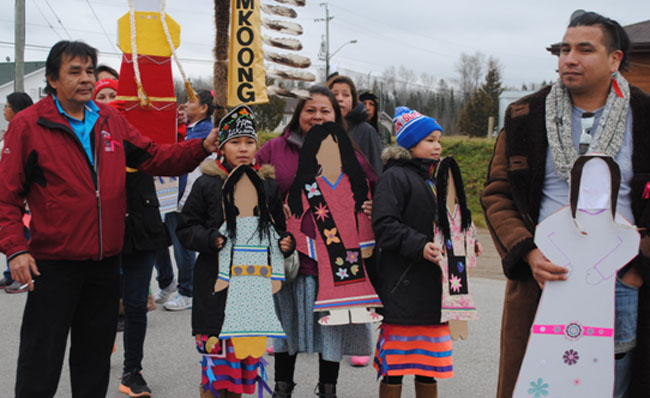Faceless Kwewag dolls commemorate National Day of Remembrance and action on violence against women

By Rick Garrick
A group of Wikwemikong community members marched with about 21 faceless Kwewag dolls to commemorate the National Day of Remembrance and Action on Violence Against Women on Dec. 7.
“(The Kwewag dolls) represented someone we knew or one of the high numbers of the missing and murdered women across our country,” says Dorothy Wassegijig-Kennedy, community wellness worker-clinician at Wikwemikong’s Health Centre. “We feel very compassionate about this national crisis, I would call it, because they are high in number.”
Most of the Kwewag dolls were created by a group of community members during two workshops on Nov. 25 and Dec. 2. The Kwewag dolls were made out of cut-out pieces of display board using a variety of fabrics, patterned paper, leather, beadwork and yarn.
“The Wikwemikong Heritage organization donated scraps of hide, which people cut up to make the moccasins and the different ornaments,” Wassegijig-Kennedy says. “And we had some bling, jewelry making stuff.”
The other Kwewag dolls were made on the morning of the walk by participants.
“The younger children were very amazed with the (Kwewag) dolls,” Wassegijig-Kennedy says, noting the children gravitated to the dolls. “And we also had a red willow tree with some pictures of the women.”
Wassegijig-Kennedy says the children were surprised the women were murdered when she answered a question about the women’s pictures.
“They said: ‘They were murdered, why would anybody do that?’” Wassegijig-Kennedy says. “So that was when I said: ’In this world there are some people who are violent and people who want to hurt others, so you have to keep doing your safety precautions at home, listen to your parents, never wander around too far away, always have a buddy system.’ So that is a good time to remind them to take care of themselves and to have that realization that maybe the world is not a safe place.”
Three missing and murdered community members were also identified by participants during the day, one who had moved back to the community, one in Toronto and one in Ottawa.
“We had quite a few people join us this year, men and women, and that is something different, something new,” Wassegijig-Kennedy says. “We’ve had a few men join us over the years.”
Wassegijig-Kennedy says the newly elected federal government’s interest in moving forward on the missing and murdered Aboriginal women and girls issue encouraged the participants.
“It was really frustrating over the last few years to have a government that was not interested in following up on this issue,” Wassegijig-Kennedy says.
The group of community members also created a Remembrance and Action on Violence Against Women banner for the walk.
“We’re often oblivious or being in denial about our own issues, our own high rate of different forms of violence in our community,” Wassegijig-Kennedy says. “It’s something to keep on the surface; we can’t bury it any longer.”
The day began with a pipe ceremony in the morning, the community walk, a guest speaker on violent issues, lunch, another guest speaker in the afternoon, an open mike for other speakers, hand drumming, a traditional feast and a community powwow with three drum groups.
“We had a traditional feast and we made spirit plates out of birch bark and a tobacco dish for each of those (Kwewag) dolls.”


